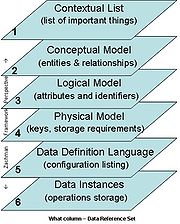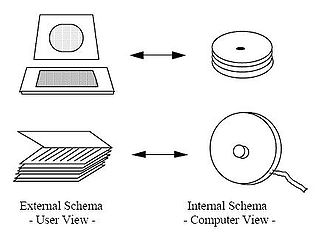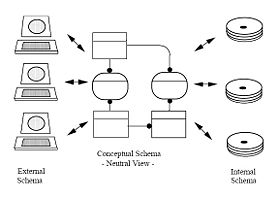
Three schema approach
Encyclopedia
The three-schema approach, or the Three Schema Concept, in software engineering
is an approach to building information systems
and systems information management
from the 1970s. It proposes to use three different views
in systems development, in which conceptual model
ling is considered to be the key to achieving data integration
.
At the center, the conceptual schema defines the ontology of the concept
s as the user
s think of them and talk about them. The physical schema according to Sowa (2004) "describes the internal formats of the data
stored in the database
, and the external schema defines the view of the data presented to the application programs". The framework attempted to permit multiple data models to be used for external schemata.
Over the years, the skill and interest in building information systems has grown tremendously. However, for the most part, the traditional approach to building systems has only focused on defining data
from two distinct views, the "user view" and the "computer view". From the user view, which will be referred to as the “external schema,” the definition of data is in the context of reports and screens designed to aid individuals in doing their specific jobs. The required structure of data from a usage view changes with the business environment and the individual preferences of the user. From the computer view, which will be referred to as the “internal schema,” data is defined in terms of file structures for storage and retrieval. The required structure of data for computer storage
depends upon the specific computer technology employed and the need for efficient processing of data.
These two traditional views of data have been defined by analysts over the years on an application by application basis as specific business needs were addressed, see Figure. Typically, the internal schema defined for an initial application cannot be readily used for subsequent applications, resulting in the creation of redundant and often inconsistent definition of the same data. Data was defined by the layout of physical records and processed sequentially in early information systems. The need for flexibility, however, led to the introduction of Database Management System
s (DBMSs), which allow for random access of logically connected pieces of data. The logical data structures within a DBMS are typically defined as either hierarchies, networks or relations. Although DBMSs have greatly improved the shareability of data, the use of a DBMS alone does not guarantee a consistent definition of data. Furthermore, most large companies have had to develop multiple databases which are often under the control of different DBMSs and still have the problems of redundancy and inconsistency.
The recognition of this problem led the ANSI/X3/SPARC Study Group on Database Management Systems to conclude that in an ideal data management environment a third view of data is needed. This view, referred to as a “conceptual schema” is a single integrated definition of the data within an enterprise which is unbiased toward any single application of data and is independent of how the data is physically stored or accessed, see figure. The primary objective of this conceptual schema is to provide a consistent definition of the meanings and interrelationship of data which can be used to integrate, share, and manage the integrity of data.
, an external model, and an internal or physical model was first introduced by the ANSI/X3/SPARC Standards Planning and Requirements Committee directed by Charles Bachman
in 1975. The ANSI/X3/SPARC Report characterized DBMSs as having a two schema organization. That is, DBMSs utilize an internal schema, which represents the structure of the data as viewed by the DBMS, and an external schema, which represents various structures of the data as viewed by the end user. The concept of a third schema (conceptual) was introduced in the report. The conceptual schema represents the basic underlying structure of data as viewed by the enterprise as a whole.
 The ANSI/SPARC report was intended as a basis for interoperable computer systems. All database vendors adopted the three-schema terminology, but they implemented it in incompatible ways. Over the next twenty years, various groups attempted to define standards for the conceptual schema and its mappings to databases and programming languages. Unfortunately, none of the vendors had a strong incentive to make their formats compatible with their competitors'. A few reports were produced, but no standards.
The ANSI/SPARC report was intended as a basis for interoperable computer systems. All database vendors adopted the three-schema terminology, but they implemented it in incompatible ways. Over the next twenty years, various groups attempted to define standards for the conceptual schema and its mappings to databases and programming languages. Unfortunately, none of the vendors had a strong incentive to make their formats compatible with their competitors'. A few reports were produced, but no standards.
As the practice of Data Administration has evolved and more graphical techniques have evolved, the term "schema" has given way to the term "model". The conceptual model represents the view of data that is negotiated between end users and database administrators covering those entities about which it is important to keep data, the meaning of the data, and the relationships of the data to each other.
One further development is the IDEF1X
information modeling methodology, which is based on the three-schema concept. Another is the Zachman Framework
, proposed by John Zachman in 1987 and developed ever since in the field of Enterprise Architecture
. In this framework, the three-schema model has evolved into a layer of six perspectives. In other Enterprise Architecture frameworks some kind of view model
is incorporated.
Software engineering
Software Engineering is the application of a systematic, disciplined, quantifiable approach to the development, operation, and maintenance of software, and the study of these approaches; that is, the application of engineering to software...
is an approach to building information systems
Information systems
Information Systems is an academic/professional discipline bridging the business field and the well-defined computer science field that is evolving toward a new scientific area of study...
and systems information management
Information management
Information management is the collection and management of information from one or more sources and the distribution of that information to one or more audiences. This sometimes involves those who have a stake in, or a right to that information...
from the 1970s. It proposes to use three different views
View model
A view model or viewpoints framework in systems engineering, software engineering, and enterprise engineering is a framework which defines a coherent set of views to be used in the construction of a system architecture, software architecture, or enterprise architecture. A view is a representation...
in systems development, in which conceptual model
Conceptual model
In the most general sense, a model is anything used in any way to represent anything else. Some models are physical objects, for instance, a toy model which may be assembled, and may even be made to work like the object it represents. They are used to help us know and understand the subject matter...
ling is considered to be the key to achieving data integration
Data integration
Data integration involves combining data residing in different sources and providing users with a unified view of these data.This process becomes significant in a variety of situations, which include both commercial and scientific domains...
.
Overview
The three-schema approach offers three types of schemas with schema techniques based on formal language descriptions:- External schema for user views
- Conceptual schemaConceptual schemaA conceptual schema or conceptual data model is a map of concepts and their relationships. This describes the semantics of an organization and represents a series of assertions about its nature...
integrates external schemata - Internal schema that defines physical storage structures
At the center, the conceptual schema defines the ontology of the concept
Concept
The word concept is used in ordinary language as well as in almost all academic disciplines. Particularly in philosophy, psychology and cognitive sciences the term is much used and much discussed. WordNet defines concept: "conception, construct ". However, the meaning of the term concept is much...
s as the user
User (computing)
A user is an agent, either a human agent or software agent, who uses a computer or network service. A user often has a user account and is identified by a username , screen name , nickname , or handle, which is derived from the identical Citizen's Band radio term.Users are...
s think of them and talk about them. The physical schema according to Sowa (2004) "describes the internal formats of the data
Data
The term data refers to qualitative or quantitative attributes of a variable or set of variables. Data are typically the results of measurements and can be the basis of graphs, images, or observations of a set of variables. Data are often viewed as the lowest level of abstraction from which...
stored in the database
Database
A database is an organized collection of data for one or more purposes, usually in digital form. The data are typically organized to model relevant aspects of reality , in a way that supports processes requiring this information...
, and the external schema defines the view of the data presented to the application programs". The framework attempted to permit multiple data models to be used for external schemata.
Over the years, the skill and interest in building information systems has grown tremendously. However, for the most part, the traditional approach to building systems has only focused on defining data
Data
The term data refers to qualitative or quantitative attributes of a variable or set of variables. Data are typically the results of measurements and can be the basis of graphs, images, or observations of a set of variables. Data are often viewed as the lowest level of abstraction from which...
from two distinct views, the "user view" and the "computer view". From the user view, which will be referred to as the “external schema,” the definition of data is in the context of reports and screens designed to aid individuals in doing their specific jobs. The required structure of data from a usage view changes with the business environment and the individual preferences of the user. From the computer view, which will be referred to as the “internal schema,” data is defined in terms of file structures for storage and retrieval. The required structure of data for computer storage
Computer storage
Computer data storage, often called storage or memory, refers to computer components and recording media that retain digital data. Data storage is one of the core functions and fundamental components of computers....
depends upon the specific computer technology employed and the need for efficient processing of data.
 |
 |
These two traditional views of data have been defined by analysts over the years on an application by application basis as specific business needs were addressed, see Figure. Typically, the internal schema defined for an initial application cannot be readily used for subsequent applications, resulting in the creation of redundant and often inconsistent definition of the same data. Data was defined by the layout of physical records and processed sequentially in early information systems. The need for flexibility, however, led to the introduction of Database Management System
Database management system
A database management system is a software package with computer programs that control the creation, maintenance, and use of a database. It allows organizations to conveniently develop databases for various applications by database administrators and other specialists. A database is an integrated...
s (DBMSs), which allow for random access of logically connected pieces of data. The logical data structures within a DBMS are typically defined as either hierarchies, networks or relations. Although DBMSs have greatly improved the shareability of data, the use of a DBMS alone does not guarantee a consistent definition of data. Furthermore, most large companies have had to develop multiple databases which are often under the control of different DBMSs and still have the problems of redundancy and inconsistency.
The recognition of this problem led the ANSI/X3/SPARC Study Group on Database Management Systems to conclude that in an ideal data management environment a third view of data is needed. This view, referred to as a “conceptual schema” is a single integrated definition of the data within an enterprise which is unbiased toward any single application of data and is independent of how the data is physically stored or accessed, see figure. The primary objective of this conceptual schema is to provide a consistent definition of the meanings and interrelationship of data which can be used to integrate, share, and manage the integrity of data.
History
The notion of a three-schema model consisting of a conceptual modelConceptual model
In the most general sense, a model is anything used in any way to represent anything else. Some models are physical objects, for instance, a toy model which may be assembled, and may even be made to work like the object it represents. They are used to help us know and understand the subject matter...
, an external model, and an internal or physical model was first introduced by the ANSI/X3/SPARC Standards Planning and Requirements Committee directed by Charles Bachman
Charles Bachman
Charles William "Charlie" Bachman is an American computer scientist, who spent his entire career as an industrial researcher rather than in academia...
in 1975. The ANSI/X3/SPARC Report characterized DBMSs as having a two schema organization. That is, DBMSs utilize an internal schema, which represents the structure of the data as viewed by the DBMS, and an external schema, which represents various structures of the data as viewed by the end user. The concept of a third schema (conceptual) was introduced in the report. The conceptual schema represents the basic underlying structure of data as viewed by the enterprise as a whole.

As the practice of Data Administration has evolved and more graphical techniques have evolved, the term "schema" has given way to the term "model". The conceptual model represents the view of data that is negotiated between end users and database administrators covering those entities about which it is important to keep data, the meaning of the data, and the relationships of the data to each other.
One further development is the IDEF1X
IDEF1X
IDEF1X is a data modeling language for the developing of semantic data models. IDEF1X is used to produce a graphical information model which represents the structure and semantics of information within an environment or system.IDEF1X permits the construction of semantic data models which may serve...
information modeling methodology, which is based on the three-schema concept. Another is the Zachman Framework
Zachman framework
The Zachman Framework is an Enterprise Architecture framework for enterprise architecture, which provides a formal and highly structured way of viewing and defining an enterprise...
, proposed by John Zachman in 1987 and developed ever since in the field of Enterprise Architecture
Enterprise architecture
An enterprise architecture is a rigorous description of the structure of an enterprise, which comprises enterprise components , the externally visible properties of those components, and the relationships between them...
. In this framework, the three-schema model has evolved into a layer of six perspectives. In other Enterprise Architecture frameworks some kind of view model
View model
A view model or viewpoints framework in systems engineering, software engineering, and enterprise engineering is a framework which defines a coherent set of views to be used in the construction of a system architecture, software architecture, or enterprise architecture. A view is a representation...
is incorporated.
See also
- Conceptual schemaConceptual schemaA conceptual schema or conceptual data model is a map of concepts and their relationships. This describes the semantics of an organization and represents a series of assertions about its nature...
- Data modelData modelA data model in software engineering is an abstract model, that documents and organizes the business data for communication between team members and is used as a plan for developing applications, specifically how data is stored and accessed....
- Data modelingData modelingData modeling in software engineering is the process of creating a data model for an information system by applying formal data modeling techniques.- Overview :...
- Entity-relationship modelEntity-relationship modelIn software engineering, an entity-relationship model is an abstract and conceptual representation of data. Entity-relationship modeling is a database modeling method, used to produce a type of conceptual schema or semantic data model of a system, often a relational database, and its requirements...
- Information systemsInformation systemsInformation Systems is an academic/professional discipline bridging the business field and the well-defined computer science field that is evolving toward a new scientific area of study...
- Object role modelingObject role modelingObject Role Modeling is a method for conceptual modeling, and can be used as a tool for information and rules analysis, ontological analysis, and data modeling in the field of software engineering.- Overview :...
- View modelView modelA view model or viewpoints framework in systems engineering, software engineering, and enterprise engineering is a framework which defines a coherent set of views to be used in the construction of a system architecture, software architecture, or enterprise architecture. A view is a representation...
External links
- Information Designing presentation by Walden 3d Inc.
- Example of an application at the Office of Hydrologic Development at the US National Weather Service.

